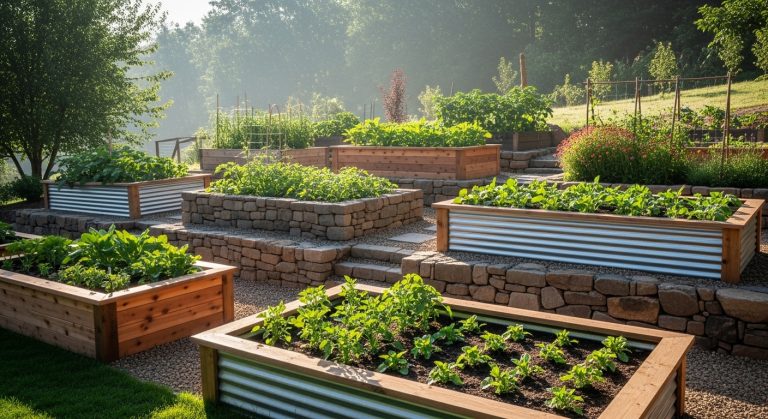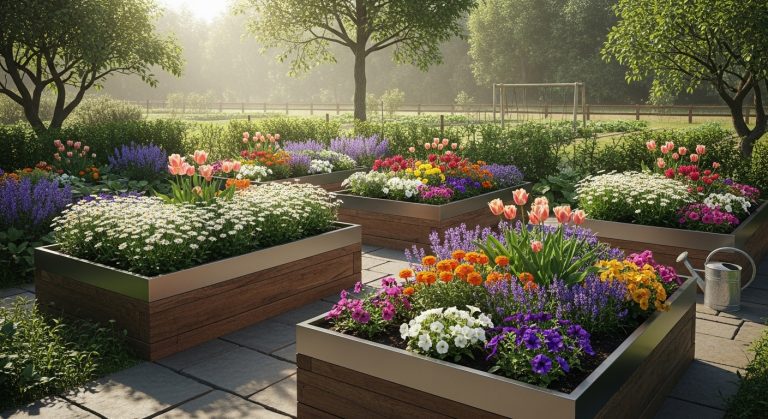Zen Garden Ideas Backyard: 15 Ways to Create a Peaceful Outdoor Escape
There’s something magical about walking into your backyard and instantly feeling your shoulders drop, your breath slow, and your mind quiet down. That’s the power of a Zen garden — it’s not just landscaping; it’s therapy disguised as gravel, stone, and plants. Whether your yard is large or modest, the right design can turn it into a sanctuary that calms chaos and whispers, “Breathe, you’ve got this.”
If you’ve been itching to transform your outdoor space into something peaceful, artistic, and low-maintenance, these 15 Zen garden ideas backyard will help you create a slice of serenity — minus the stress of constant upkeep.
1. The Classic Raked Sand & Stone Layout
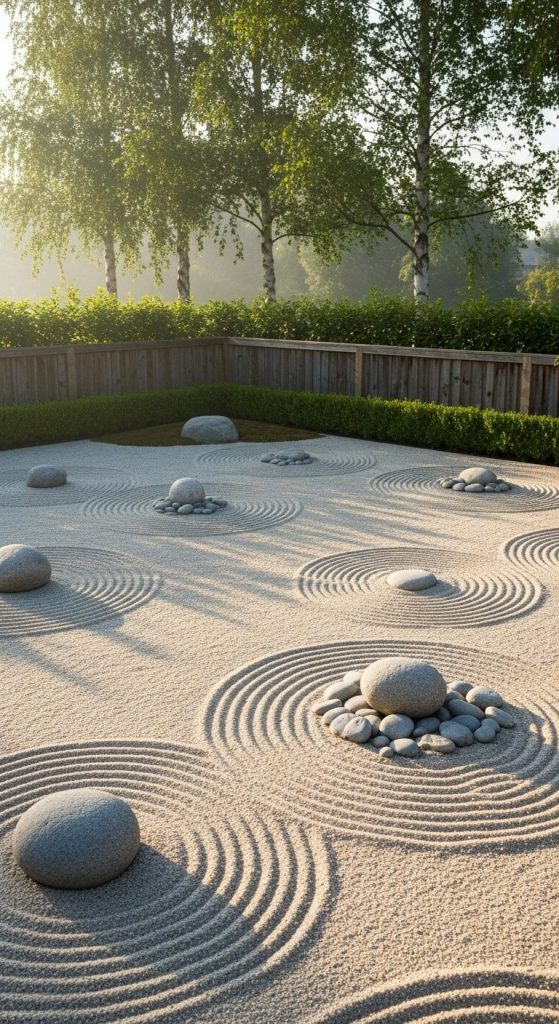
The foundation of any great Zen garden starts with raked sand or gravel and carefully placed stones. This setup represents the flow of water and islands of tranquility — even without a single drop of actual water.
Pros:
- Incredibly low maintenance once installed.
- Ideal for creating visual calm and simplicity.
- You can easily change the patterns with a rake whenever you feel inspired.
Cons:
- Sand can scatter during windy days.
- Not ideal for households with pets that love to dig (trust me on this one).
Pro Tip: Use fine crushed granite or pea gravel for longevity and a more polished look.
2. Bamboo Border Haven
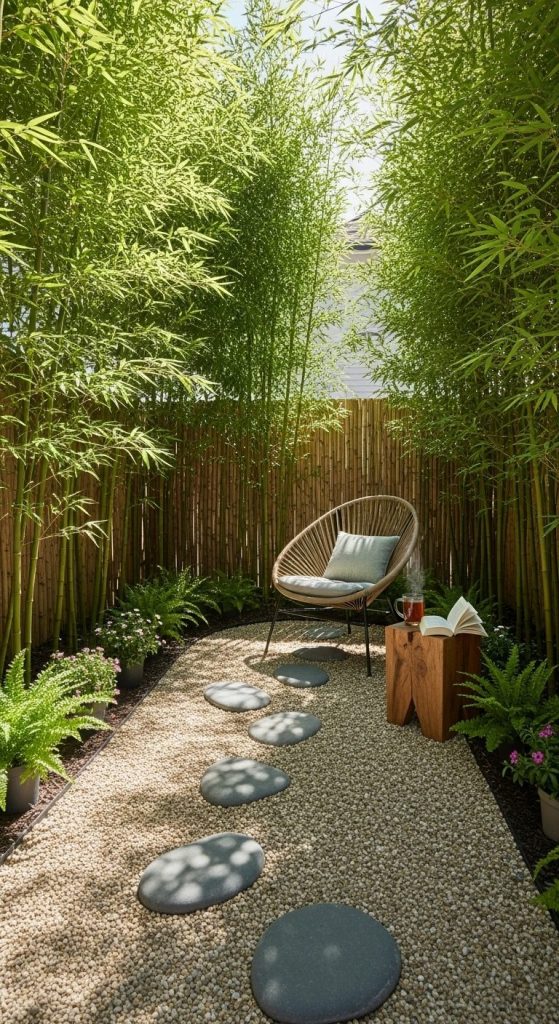
Ever wondered why bamboo just feels Zen? It’s the perfect combination of structure and nature. A bamboo border not only adds height and texture but also provides a soft, rustling sound when the wind blows — instant tranquility.
Pros:
- Natural privacy screen without harsh fencing.
- Grows quickly, adding lush green coverage.
- The sound is genuinely relaxing — like nature’s wind chime.
Cons:
- Can become invasive if not contained.
- Requires periodic trimming to maintain shape.
FYI: Opt for clumping bamboo species to avoid unwanted spread (your neighbors will thank you).
3. Water Feature Serenity
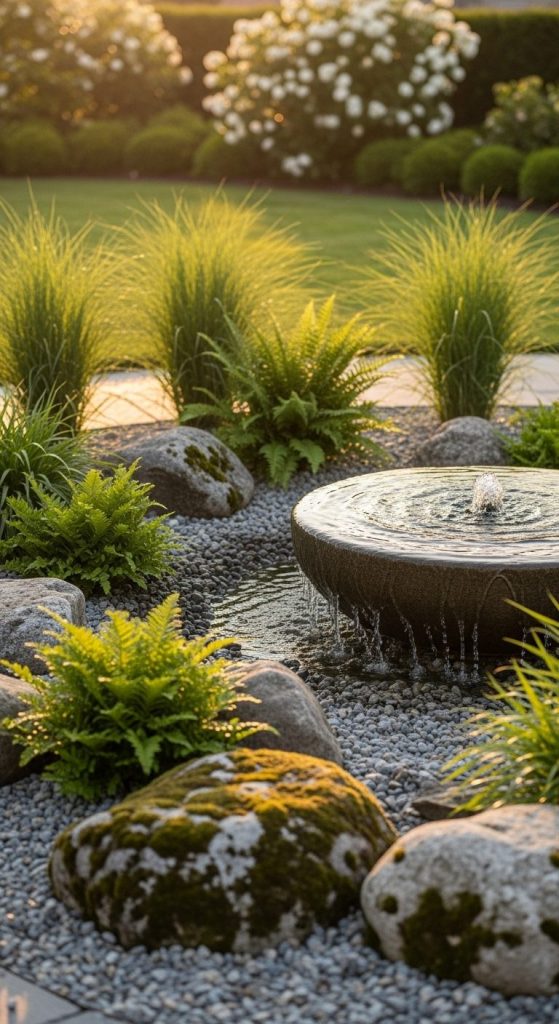
Nothing brings balance like the sound of flowing water. A small pond, bubbling stone fountain, or even a waterfall wall can turn a static garden into a living, breathing experience.
Pros:
- Promotes relaxation through sound and motion.
- Attracts birds and butterflies, adding life to your space.
- Enhances humidity levels in dry climates.
Cons:
- Needs occasional cleaning to prevent algae.
- Slightly higher installation cost.
According to a 2023 Houzz survey, 62% of homeowners said a water feature was the “most calming” part of their outdoor space. Not a bad reason to install one.
4. Moss & Stone Pathway

Create a moss-covered stone path that weaves through your garden. It feels ancient, grounded, and irresistibly peaceful — like walking through a temple courtyard.
Pros:
- Soft underfoot and visually soothing.
- Perfectly complements stone sculptures or lanterns.
- Low water requirement once established.
Cons:
- Needs partial shade to thrive.
- Can be slippery when wet.
If you’ve got a shady corner that looks dull, moss will turn it into a lush green carpet of calm.
5. Gravel River Stream
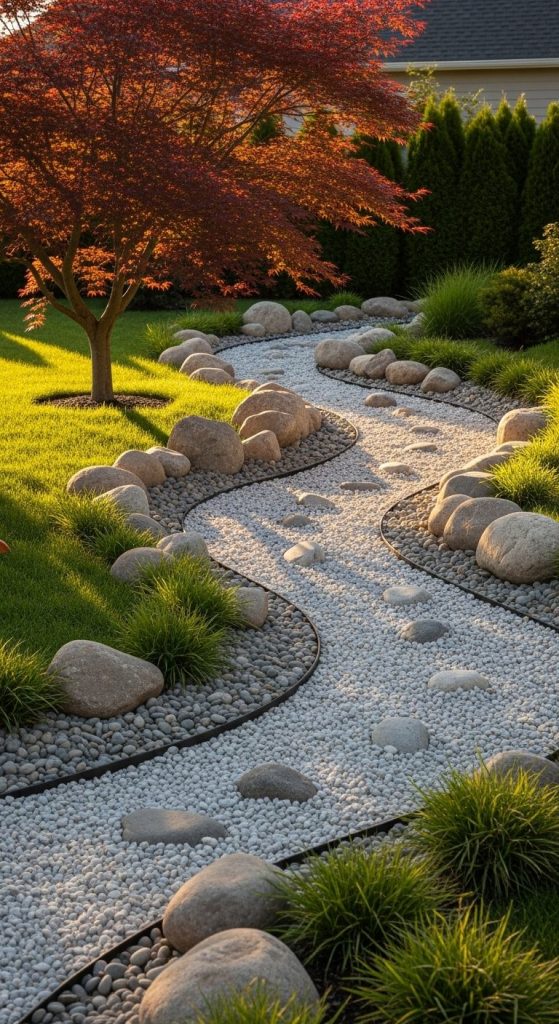
Design a dry riverbed using gravel and stones to mimic the flow of a real stream. It’s symbolic of life’s flow and perfect for Zen minimalism.
Pros:
- Adds natural movement without actual water.
- Great drainage solution for low-lying areas.
- Low-cost and easy to maintain.
Cons:
- Requires careful placement to avoid looking artificial.
Want to level it up? Use contrasting stone colors to make the “stream” visually dynamic.
6. Japanese Maple Focal Point
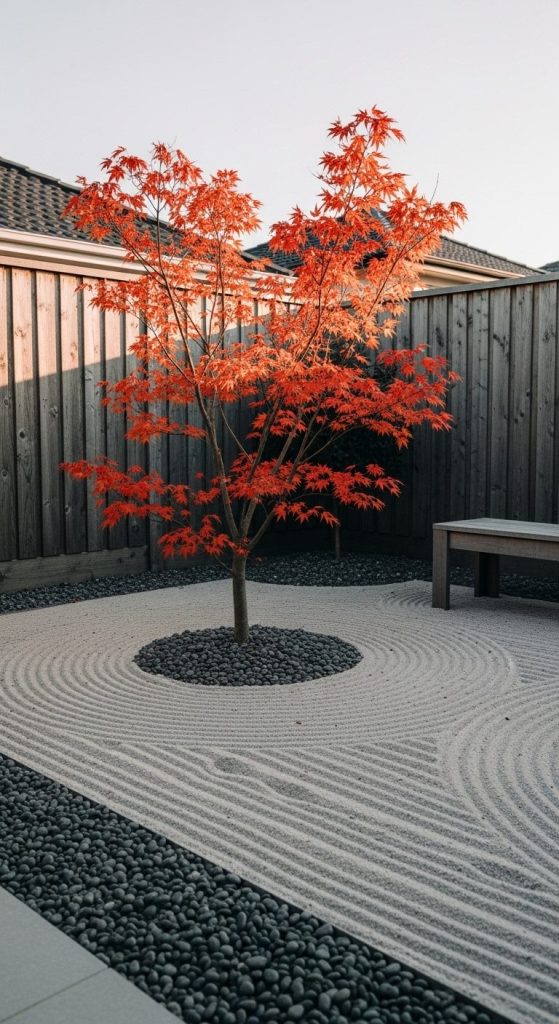
Few plants can match the grace of a Japanese maple. Its delicate leaves and vivid colors bring instant harmony and seasonal beauty to your Zen retreat.
Pros:
- Stunning year-round color and form.
- Compact growth fits many yard sizes.
- Symbolizes peace and balance.
Cons:
- Requires protection from strong afternoon sun.
- A bit pricier than standard trees.
In Japan, maples are considered symbols of tranquility and reflection — exactly what your backyard deserves.
7. Stone Lantern Corners
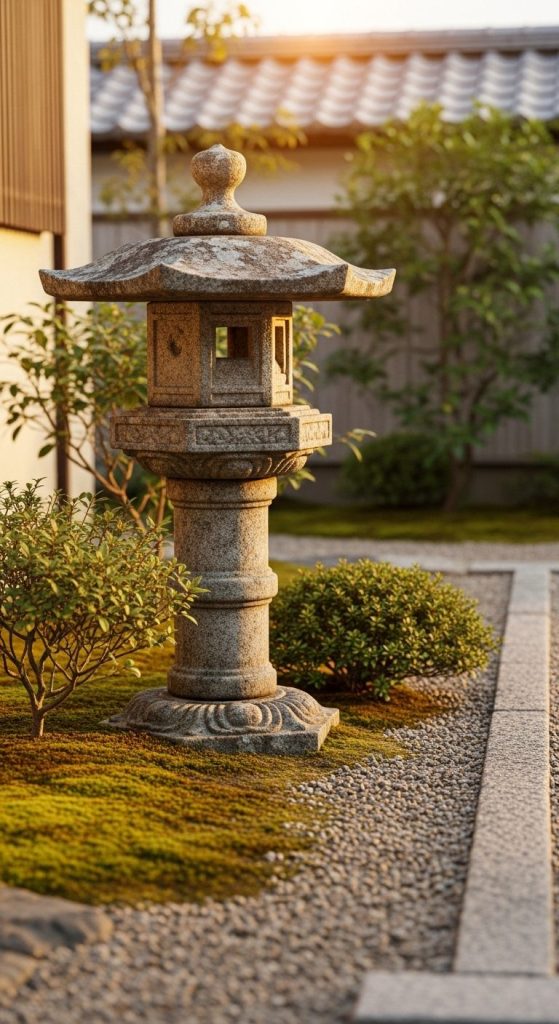
Nothing says Zen like a Japanese stone lantern tucked among greenery. It gives structure, soft illumination, and a timeless sense of artistry.
Pros:
- Adds sculptural elegance.
- Works beautifully with both sand and moss backgrounds.
- Can be solar-lit for night ambiance.
Cons:
- Heavy and requires a stable base.
IMO, this is the easiest way to add instant authenticity without overdoing it.
8. Minimalist Seating Nook
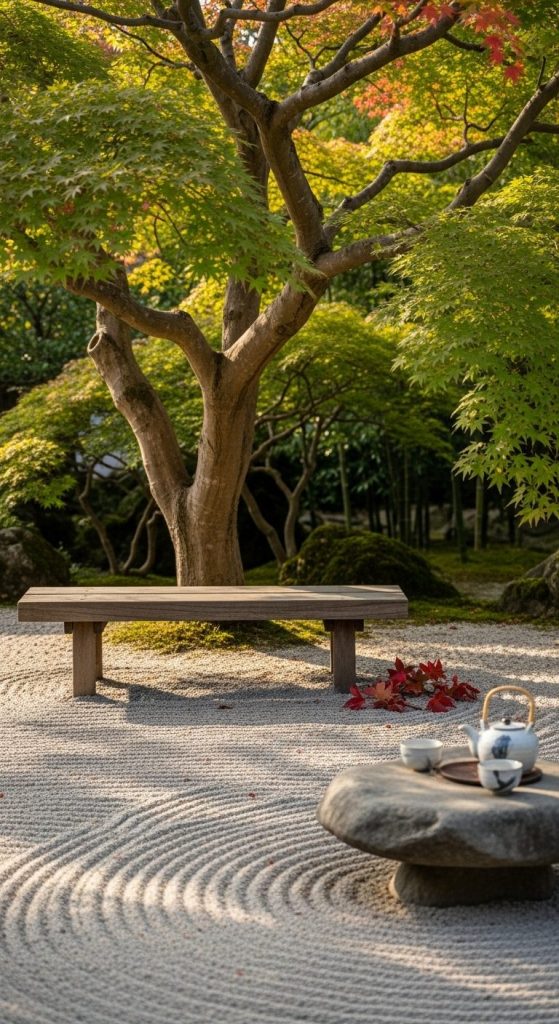
Even the calmest space needs a place to sit and reflect. Build a wooden bench or stone seat near a feature like a pond or raked area.
Pros:
- Invites meditation or quiet morning coffee moments.
- Blends comfort with nature.
- Encourages mindfulness and stillness.
Cons:
- Wood may weather; stone can feel cold.
Pro Tip: Use weathered teak or smooth concrete for balance between form and function.
9. Zen Gravel Courtyard

Transform an entire section of your backyard into a gravel courtyard with geometric or circular sand rakes. Add stepping stones for flow and structure.
Pros:
- Extremely low-maintenance and weed-resistant.
- Perfect for minimalists.
- Ideal for meditation or yoga sessions.
Cons:
- Can heat up in direct sunlight.
- Lacks shade unless paired with trees.
If you’re someone who finds mowing a chore, this is your dream setup.
10. Stone Sculptures & Art Accents

In Zen design, balance is everything — and nothing achieves that better than a few well-placed stone sculptures. Whether abstract or Buddha-inspired, art becomes part of the landscape.
Pros:
- Adds symbolic meaning and focal interest.
- Durable across all weather conditions.
- Complements sand, gravel, and plants equally.
Cons:
- Overuse can clutter the minimalist vibe.
Less is more here — one or two statement pieces do the trick.
11. Stepping Stone Path to Nowhere
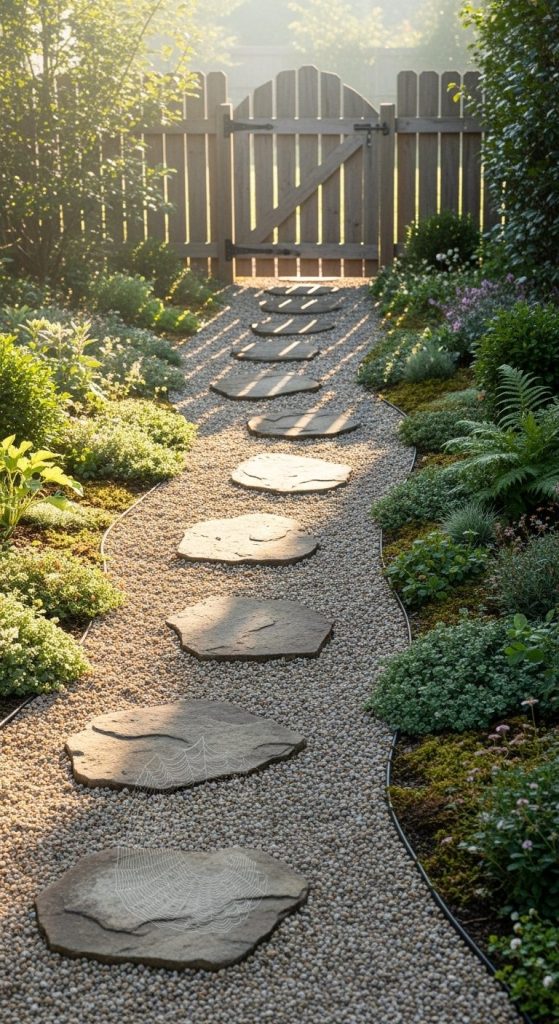
Sounds odd, right? A path to nowhere symbolizes the journey within — a Zen concept that celebrates being present rather than reaching a destination.
Pros:
- Adds intrigue and mystery.
- Visually connects different garden zones.
- Low maintenance and elegant.
Cons:
- Needs spacing precision for visual harmony.
The next time someone asks where your path leads, just smile and say, “Wherever your mind needs to go.”
12. Evergreen Harmony

Balance your stone elements with evergreen plants like boxwood, juniper, or dwarf pines. They bring life without disturbing the stillness.
Pros:
- Year-round color and structure.
- Low water needs once established.
- Resilient against seasonal changes.
Cons:
- Requires occasional trimming.
According to Statista (2024), evergreen species now make up 40% of modern Zen garden plant choices — proof that consistency never goes out of style.
13. Floating Deck Retreat

Combine modern architecture with Zen spirit by adding a small floating wooden deck that slightly elevates above your gravel or moss area.
Pros:
- Defines a seating or meditation zone.
- Visually contrasts with natural textures.
- Perfect spot for yoga or tea ceremonies.
Cons:
- Needs regular sealing to prevent weather damage.
Pair it with a single bonsai or lantern for a balanced composition.
14. Subtle Lighting Magic

Proper lighting turns your Zen garden into a nighttime masterpiece. Use low-voltage LED or solar path lights to highlight textures, trees, and water features.
Pros:
- Extends garden usability into evening hours.
- Creates a tranquil glow without harsh brightness.
- Energy-efficient when solar-powered.
Cons:
- Initial wiring can be tricky.
Remember: Zen lighting isn’t about seeing everything — it’s about feeling everything quietly.
15. The Complete Harmony Layout
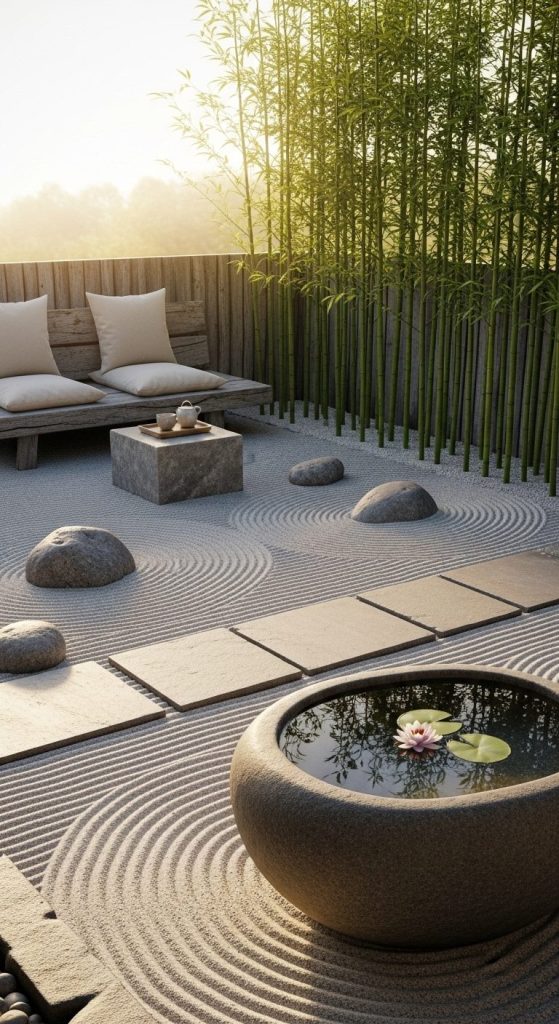
Finally, blend all the above into your ultimate Zen backyard — a space that balances rock, sand, water, and life. Divide areas by purpose: a raked zone for calm, a water feature for flow, and a seating area for reflection.
Pros:
- Creates a full sensory experience.
- Customizable to your preferences and space.
- Offers year-round serenity.
Cons:
- Planning takes time and attention to proportion.
But once complete, this is no longer a “backyard.” It’s your personal retreat from chaos — no flight ticket to Kyoto required.
Conclusion
Building a Zen garden in your backyard isn’t about following strict rules; it’s about crafting peace on your terms. Whether you start with a single stone lantern or a complete landscape overhaul, the goal remains the same: harmony, simplicity, and reflection.
So next weekend, grab that rake, move those stones, and create a space that whispers serenity every time you step outside. Your future self (and probably your blood pressure) will thank you.

Ashley Ellison is a skilled writer and avid bowler. Her passion for storytelling and dedication to the sport have led her to participate in various national bowling leagues. With a unique combination of talents, Ashley approaches every challenge with creativity and a relentless drive to succeed.


